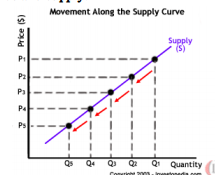Economics miscellaneous
- “Marginal Cost” equals
-
View Hint View Answer Discuss in Forum
Marginal cost is the change in the total cost that arises when the quantity produced has an increment by unity. That is, it is the cost of producing one more unit of a good. To illustrate marginal cost let’s assume that the total cost of producing 10,000 units is Rs. 50,000. If we produce a total of 10,001 units the total cost is Rs. 50,002. That would mean the marginal cost—the cost of producing the next unit—was Rs. 2.
Correct Option: D
Marginal cost is the change in the total cost that arises when the quantity produced has an increment by unity. That is, it is the cost of producing one more unit of a good. To illustrate marginal cost let’s assume that the total cost of producing 10,000 units is Rs. 50,000. If we produce a total of 10,001 units the total cost is Rs. 50,002. That would mean the marginal cost—the cost of producing the next unit—was Rs. 2.
- Goods which are meant either for consumption or for investment are called
-
View Hint View Answer Discuss in Forum
All goods which are meant either (i) for consumption by consumers or (ii) for investment by firms are called final goods. They are finished goods, meant for final use. These are neither resold nor do they enter into further stages of production. Cars, television sets, cloth, food, machinery, equipments etc. are final goods.
Correct Option: A
All goods which are meant either (i) for consumption by consumers or (ii) for investment by firms are called final goods. They are finished goods, meant for final use. These are neither resold nor do they enter into further stages of production. Cars, television sets, cloth, food, machinery, equipments etc. are final goods.
- A supply function expresses the relationship between
-
View Hint View Answer Discuss in Forum
The supply function expresses the relationship between the total quantity supplied and the price received by all suppliers per unit of time, holding other factors constant. It illustrates the relation between price and supply.
The diagram (Price is shown on the Y-axis and Quantity per day on the X-axis) shows that suppliers will produce quantity Q1 units of a good if the price they receive is P1. As the price keeps decreasing, the quantity produced also keeps on decreasing. So though the supply function has to do with supply and price, it can be perceived to express similar functional relationship between price and output (in terms of quantity that will be produced).
Correct Option: A
The supply function expresses the relationship between the total quantity supplied and the price received by all suppliers per unit of time, holding other factors constant. It illustrates the relation between price and supply.
The diagram (Price is shown on the Y-axis and Quantity per day on the X-axis) shows that suppliers will produce quantity Q1 units of a good if the price they receive is P1. As the price keeps decreasing, the quantity produced also keeps on decreasing. So though the supply function has to do with supply and price, it can be perceived to express similar functional relationship between price and output (in terms of quantity that will be produced).
- Tha Law of Demand is based on
-
View Hint View Answer Discuss in Forum
The Law of Demand states that, all else being equal, as the price of a product increases, quantity demanded lowers; likewise, as the price of a product decreases, quantity demanded increases. Demand is derived from consumers’ tastes and preferences, and it is bound by income. In other words, given a limited income, the consumer must decide what goods and services to purchase. Each consumer will purchase different things because individual preferences and incomes differ.
Correct Option: D
The Law of Demand states that, all else being equal, as the price of a product increases, quantity demanded lowers; likewise, as the price of a product decreases, quantity demanded increases. Demand is derived from consumers’ tastes and preferences, and it is bound by income. In other words, given a limited income, the consumer must decide what goods and services to purchase. Each consumer will purchase different things because individual preferences and incomes differ.
- Third stage of Law of Variable Proportion is called
-
View Hint View Answer Discuss in Forum
The stages of Law of Variable Proportion are: Stage 1: Increasing return; Stage 2: Diminishing return; and Stage 3: Negative Return. In the third stage Marginal Product of variable factor is zero. In this stage the Total Product starts diminishing.
Correct Option: A
The stages of Law of Variable Proportion are: Stage 1: Increasing return; Stage 2: Diminishing return; and Stage 3: Negative Return. In the third stage Marginal Product of variable factor is zero. In this stage the Total Product starts diminishing.

